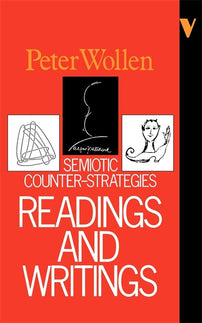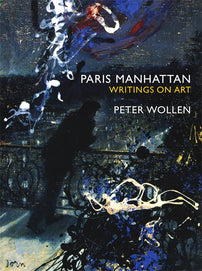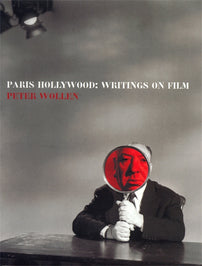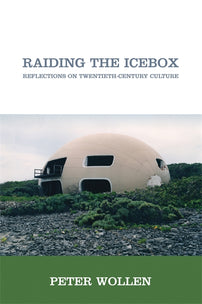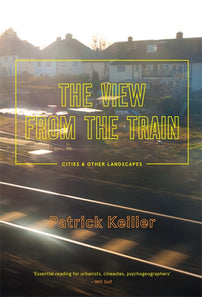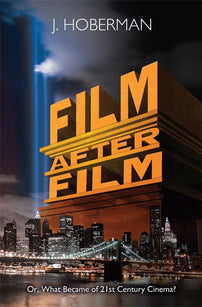The Two Avant-Gardes
Peter Wollen's landmark essay on the relation between two distinct traditions of avant-garde film.

Published in 1982, Readings and Writings: Semiotic Counter-Strategies, was the first of four collections of Peter Wollen's cultural writings to be published by Verso. As Wollen describes in his preface:
This book collects together essays and fictions written during the period from 1968 to 1982 and published in a variety of magazines and journals, of which the most significant for me personally were Screen and Bananas. In different ways they attempt to develop a series of semiotic counter-strategies both in theory and in practice. During this period, as can be seen very clearly in the work of Barthes and Derrida, the classical distinctions between object-language and meta-language, between text and commentary or analysis, began to break down. The division of labour between theory and practice is one that a cultural counter-strategy should seek to overcome. Rather than dissolve one into the other, however, my strategy was to work in both areas, and to explore some of the relations between them. The volume contains fictions as well as analytic and critical texts; the fictions incorporate elements of theoretical discourse, and a few of the essays — most clearly that on Kahlo and Modotti – make use of fictional forms. These essays and fictions thus present different aspects of work from a common aesthetic position. During this period I also made a number of films, with Laura Mulvey: Penthesilea, Riddles of the Sphinx, AMY!, and Crystal Gazing. These form part of the same heterogeneous corpus.
Included in the collection and reprinted below is Wollen's landmark essay — first published in Screen International in 1975 — on the relation between the two distinct traditions of avant-garde film.
Film history has developed unevenly, so that in Europe today there are two distinct avant-gardes. The first can be identified loosely with the Co-op movement. The second would include film-makers such as Godard, Straub and Huillet, Hanoun, Jancso. Naturally there are points of contact between these two groups and common characteristics, but they also differ quite sharply in many respects: aesthetic assumptions, institutional framework, type of financial support, type of critical backing, historical and cultural origin. There are other film-makers too who do not fit neatly into either camp, and films which fall somewhere in between or simply somewhere else — Jackie Raynal's Deux Fois, for instance — but in general the distinction holds good.
At the extreme, each would tend to deny the others the status of avant-garde at all. Books like Steve Dwoskin's Film Is or David Curtis's Experimental Film 1 do not discuss the crucial post-1968 work of Godard and Gorin, for example. And supporters of Godard — and Godard himself — have often denounced the "Co-op avant-garde" as hopelessly involved with the established bourgeois art world and its values. The reasons for dismissal are often quite beside the point and misplaced. By no means all the directors (to use a word taboo in the other camp) in one group work with narrative in 35mm, as you might sometimes imagine — Godard has worked in 16mm for years and recently with video (to open up another hornet's nest). Conversely, many Co-op film-makers are well aware of political issues and see themselves in some sense as militant. (Not that political militancy in itself is any guarantee of being avant-garde.)
The position is complicated too by the fact that in North America there is only one avant-garde, centred on the various Co-ops. There are no obvious equivalents of Godard or Straub-Huillet, although their influence can occasionally be seen — in Jon Jost’s Speaking Directly for example. Moreover, American critics and theorists of the avant-garde have long tended to overlook their European counterparts or see them as derivative. The Europeans — and perhaps particularly the English — then tend to react by stressing their own credentials, making claims to have occupied the same ground as the Americans earlier or independently. From outside, the quarrel often looks of secondary importance. After all, no-one denies that the capital of narrative fiction 35mm filmmaking is Hollywood, however innovative European directors, such as Antonioni or Fellini or Truffaut may be. In the same way, New York is clearly the capital of the Co-op movement. Consequently, from New York, Godard looks much more distinctively European than Kren or Le Grice, a fact which simply reflects the realities of power in the art world, to which the Co-op movement is closely tied. Indeed, there is a sense in which avant-garde Co-op film-making in Europe is closer to New York than Californian film-making is, and the leading New York critics and tastemakers — Sitney, Michelson — are not appreciated in San Francisco any more than they are in London.
It seems to me much more important to try and understand what unites and separates Godard and Straub-Huillet on the one hand, and, say, Gidal and Wyborny on the other hand, than what unites and separates Europe and North America within the Co-op ambit. Moreover, I think the absence of any avant-garde of the Godard type in North America could ultimately prove a severe limitation on the development of the New American Cinema itself, narrowing its horizons and tying it unnecessarily closely to the future of the other visual arts, condemning it to a secondary status within the art world. Close relationship with "art" — painting, post-painting — is both a strength and a weakness.
To understand further the split which has developed within the avant-garde it is necessary to go back into history. A similar split can be seen in the twenties. On the one hand films were being made by Léger-Murphy, Picabia-Clair, Eggeling, Richter, Man Ray, Moholy-Nagy and others — many of them discussed in Standish Lawder's recent book on The Cubist Cinema 2 — that were attempts to extend the scope of painting, to move outside the confines of the canvas, to introduce the dimension of time, to use light directly as well as colour, and so on. On the other hand, there were the Russian directors, whose films were clearly avant-garde but in a different sense: Eisenstein's Strike, Dovzhenko's Zvenigora, Vertov's Man with the Movie Camera. It was only at the very end of the decade that there was any real contact between the two groups — when Lissitizky (whose ideas about the electro-mechanical spectacle and admiration for Eggeling put him clearly in the "painters" group) first met Vertov to discuss the Stuttgart Film und Foto exhibition 3, and when Eisenstein met Richter on his first trip out of the Soviet Union and went with him to the conference at Le Sarraz, which turned out to mark the end rather than the beginning of an epoch.
As today, part of the difference lies in the backgrounds of the people involved. One group came from painting. The other from theatre (Eisenstein), and futurist sound-poetry (Vertov) — Dovzhenko, in fact, had trained as a painter but deliberately gave it up, leaving all his painting materials behind him in Kharkov when he set off for Odessa and the film studios, seeking a complete break with his past. And, of course, there are premonitory links between these different currents of the twenties and those of recent years — Godard and Gorin carried out their collaboration under the name of the Dziga Vertov group; Van Doesburg, in 1929, already anticipated many of the ideas of "expanded cinema," realized decades later: "The spectator space will become part of the film space. The separation of 'projection surface' is abolished. The spectator will no longer observe the film, like a theatrical presentation, but will participate in it optically and acoustically." 4
Painting, I think it can be argued, played the leading role in the development of modernism in the other arts. The break, the coupure — to use the Althusserian terminology — the shift of terrain that marked the substitution of one paradigm or problematic for another, the beginning of modernism, the work of the historic avant-garde, was a break that took place in painting pre-eminently, with the discoveries of Cubism. It is not hard to show how painting affected the other arts, how early Cubism had a decisive impact on Gertrude Stein and Ezra Pound, for example, in literature, and later on William Carlos Williams, Apollinaire, Marinetti, Mayakovsky, Khlebnikov — all were influenced at a crucial point by their encounter with Cubism. The innovations of Picasso, and Braque, were seen as having an implication beyond the history of painting itself. They were intuitively felt, I think, very early on, to represent a critical semiotic shift, a changed concept and practice of sign and signification, which we can now see to have been the opening-up of a space, a disjunction between signifier and signified and a change of emphasis from the problem of signified and reference, the classic problem of realism, to that of signifier and signified within the sign itself. 5
When we look at the development of painting after the Cubist breakthrough, however, we see a constant trend towards an apparently even more radical development: the suppression of the signified altogether, an art of pure signifiers detached from meaning as much as from reference, from Sinn as much as from Bedeutung. This tendency towards abstraction could be justified in various ways — a transcendental signified could be postulated, in symbolist or spiritualist terms, a meaning located in the Uberwelt of pure ideas; a theory of formalism, of art as pure design, could be proposed; the work of art could be defended in terms of objecthood, pure presence; it could be explained as a solution to a problem, often set by the relationship between a signifier — a form of expression, in Hjelmslev's phrase — and its physical, material support (the matter or substance of expression). 6
Literature, on the other hand, tended to fall back into forms of writing in which the signified clearly remained dominant. Modernism could be interpreted in terms of the expansion of subject-matter, new narrative techniques (stream of consciousness) or play on the paradoxes of meaning and reference (Pirandellism). It is significant, for instance, that so many of the most radical experiments, such as attempts at sound poetry, were the work of artists or writers working closely with painters: Arp, Schwitters, Van Doesburg among them. In theatre the most radical developments were invariably associated with changes in set design and costume, including the use of masks: Meyerhold's Constructivist theatre in the Soviet Union, Schlemmer's Bauhaus theatre, Artaud. In this context, it should be added, Brecht appears as little more than a moderate.
Cinema is, of course, a form of art employing more than one channel, more than one sensory medium, and uses a multiplicity of different types of code. It has affinities with almost all the other arts. Music and verbal language, as well as natural or artificial noise, can form elements of the sound-track. Theatre and dance can be elements of the pro-filmic event, placed in front of the camera to be photographed. Editing can be used to develop narrative or to produce a "visual rhythm" by analogy with music. Film itself can be painted or paintings can be animated. Light can be used as a medium, and through projection a third dimension can be introduced, to produce a kind of mobile light sculpture. Cinema too has its own "specifically cinematic'" 7 codes and materials, associated with the various phases of film production.
As a result of this variety and multiplicity, ideas have fed into film-making from a variety of sources in the other arts. One powerful influence has come from painting, bringing with it a tendency to abstraction — pure light or colour; and non-figurative design—or deformation of conventional photographic imagery, involving prismatic fragmentation and splintering, the use of filters or stippled glass, mirror-shots, extreme and microscopic close-ups, bizarre angles, negative images, all of which are to be found in twenties films. Editing tended to follow principles of association (related to poetry or dream) or analogies with musicshots of fixed length, repetition and variation, attempts at synesthetic effects, theories of counterpoint.
But this influence, and the films associated with it, are marked as much by what they excluded as what they included. Primarily of course verbal language was missing and also narrative. During the silent period, the absence of language was not foregrounded; it seemed a natural quality of film, but in retrospect its significance can be seen. Language is still excluded from an enormous number of avant-garde films, which are shown either silent or with electronic or other musical tracks. Again, there are real technical and financial reasons for this, but these practical disincentives coincide with an aesthetic itself founded on concepts of visual form and visual problems that exclude verbal language from their field, and may be actively hostile to it. This is part of the legacy of the Renaissance that has survived the modernist break almost unchallenged, except in isolated instances — Lissitzky, Duchamp, Picabia and, extremely important, recent conceptualist work.
There is one further important point that must be made about the development of film in relation to art history. Film-makers at a certain point became dissatisfied with the search simply for "kinetic solutions to pictorial problems," 8 as in the films of Man Ray and Moholy-Nagy, and began to concentrate on what they saw as specifically cinematic problems. Structural film-making over the last decade has thus represented a displacement of concerns from the art world to the film world rather than an extension. This way of thinking about art has remained one that film-makers have in common with painters and other visual artists, but an effort has been made to insist on the ontological autonomy of film. Thus, for instance, Gidal's work has foregrounded and been in a sense "about" focus; Le Grice's work has foregrounded and been in a sense "about" printing or projection. The tendency of painting to concentrate on its own sphere of materials and signification, to be self-reflexive, has been translated into specifically cinematic terms and concerns, though here again "specifically cinematic" is taken to mean primarily the picture-track.
Thus the impact of avant-garde ideas from the world of visual arts has ended up pushing film-makers into a position of extreme "purism" or "essentialism." Ironically, anti-illusionist, anti-realist film has ended up sharing many preoccupations in common with its worst enemies. A theorist like André Bazin, for instance, committed to realism and representationalism, based his commitment on an argument about cinematic ontology and essence that he saw in the photographic reproduction of the natural world. We now have, so to speak, both an extroverted and an introverted ontology of film, one seeking the soul of cinema in the nature of the pro-filmic event, the other in the nature of the cinematic process, the cone of light or the grain of silver. The frontier reached by this avant-garde has been an ever-narrowing preoccupation with pure film, with film "about" film, a dissolution of signification into objecthood or tautology. 9 I should add, perhaps, that this tendency is even more marked in the United States than in Europe.
Where does the other avant-garde stand? Here, as one would expect, the tendency goes in the opposite direction. The Soviet directors of the twenties, though they saw themselves in some sense as avant-garde, were also preoccupied with the problem of realism. For the most part they remained within the bounds of narrative cinema. The most clearly avant-garde passages and episodes in Eisenstein's films (experiments in intellectual montage) remain passages and episodes, which appear as interpolations within an otherwise homogeneous and classical narrative. There is no doubt that the dramaturgy is modernist rather than traditional — the crowd as hero, typage, guignol — but these are not features that can be attributed to a break with rather than a renovation of classical theatre. They are modes of achieving a heightened emotional effect or presenting an idea with unexpected vividness or force.
In Eisenstein's work the signified — content in the conventional sense — is always dominant and, of course, he went so far as to dismiss Vertov's Man with the Movie Camera as "formalist jackstraws and unmotivated camera mischief," 10 contrasting its use of slow motion with Epstein's La Chute de la Maison Usher, in which, according to Eisenstein, it is used to heighten emotional pressure, to achieve an effect in terms of a desired content or goal. Vertov's film was, of course, a milestone for the avant-garde and it is a sign of its richness that it can be seen as a precursor both of cinema-verité and of structural film, though also, evidently, a sign of its ambiguity, of its uncertainty caught between an ideology of photographic realism and one of formal innovation and experiment.
In broad terms, what we find with the Soviet film-makers is a recognition that a new type of content, a new realm of signifieds, demands formal innovation, on the level of the signifier, for its expression. Thus Eisenstein wanted to translate the dialectical materialism of his world-view from an approach to subject-matter to an approach to form, through a theory of montage that was itself dialectical. The aesthetic was still content-based, it saw signifiers primarily as means of expression, but at the same time it demanded a radical transformation of those means. It was an aesthetic that had much in common with the avant-garde positions of, say, Léger or Man Ray, but which also kept a distance, a distance of which the fear of formalism is symptomatic. It is as if they felt that once the signifier was freed from bondage to the signified, it was certain to celebrate by doing away with its old master altogether in a fit of irresponsible ultra-leftism and utopianism. As we have seen, this was not so far wrong.
The case of Godard, working forty years or so later, is slightly different. In Godard's post-1968 films we glimpse something of an alternative route between contentism and formalism, a recognition that it is possible to work within the space opened up by the disjunction and dislocation of signifier and signified. Clearly Godard was influenced by Eisenstein’s theory of dialectical montage, but he develops it in a much more radical way. In the last resort, for Eisenstein, conflict occurred primarily between the successive signifieds of images. Although he recognizes a form of dialectical montage in the suprematist paintings of Malevich, he himself remains within the confines of "naturalism." (Interestingly enough, he identifies a middle road between naturalism and abstraction, which he relates, somewhat surprisingly, to Balla and "primitive Italian futurism"). 11 Godard takes the idea of formal conflict and struggle and translates it into a concept of conflict, not between the content of images, but between different codes and between signifier and signified.
Thus, in Le Gai Savoir, which he began shooting before the events of May 1968, but completed after, Godard tries programatically to "return to zero," to de-compose and then re-compose sounds and images. For Godard, conflict becomes not simply collision through juxtaposition, as in Eisenstein's model, but an act of negativity, a splitting apart of an apparently natural unity, a disjunction. Godard's view of bourgeois communication is one of a discourse gaining its power from its apparent naturalness, the impression of necessity that seems to bind a signifier to a signified, a sound to an image, in order to provide a convincing representation of the world. He wants not simply to represent an alternative "world" or alternative "world-view," but to investigate the whole process of signification out of which a world-view or an ideology is constructed. Le Gai Savoir ends with the following words on the soundtrack: "This film has not wished to, could not wish to explain the cinema or even constitute its object, but more modestly, to offer a few effective means for arriving there. This is not the film that must be made, but it shows how, if one is to make a film, one must necessarily follow some of the paths travelled here." 12 In other words, the film deliberately suspends "meaning," avoids any teleology or finality, in the interests of a destruction and re-assembly, a re-combination of the order of the sign as an experiment in the dissolution of old meanings and the generation of new ones from the semiotic process itself.
Put another way, Le Gai Savoir is not a film with a meaning, something to say about the world, nor is it a film "about" film (which, after all, is simply a limited part of the world of interest in itself to film-makers and film-students) but a film about the possibility of meaning itself, of generating new types of meaning. The array of sign-systems at work in the cinema are thus brought into a new kind of relationship with each other and with the world. Nor, of course, is Godard indifferent to what types of new meaning are produced. Although his work is open-ended, it does not offer itself simply for a delirium of interpretation, as though meaning could be read in at will by the spectator. Signifieds are neither fixed, or fixed as far as possible, as they are in conventional cinema, nor are they freed from any constraint, as though the end of a content-dominated art meant the end of any control over content.
In a sense, Godard's work goes back to the original breaking-point at which the modern avant-garde began — neither realist or expressionist, on the one hand, nor abstractionist, on the other. In the same way, the Demoiselles d'Avignon is neither realist, expressionist, or abstractionist. It dislocates signifier from signified, asserting — as such a dislocation must — the primacy of the first, without in any way dissolving the second. It is not a portrait group or a study of nudes in the representational tradition, but on the other hand, to see it simply as an investigation of painterly or formal problems or possibilities is to forget its original title, Le Bordel Philosophique. The same could be said, of course, about The Large Glass. The battle between realism/illusion/"literature" in art, and abstraction/reflexiveness/Greenberg-modernism, is not so simple or all-encompassing as it may sometimes seem.
There are two other topics that should be mentioned here. The first is politics. As I suggested above, it is often too easily asserted that one avant-garde is "political" and the other is not. Peter Gidal, for example, defends his films on grounds that clearly imply a political position. And the supporters of Godard and Straub-Huillet, by distinguishing their films from those of Karmitz or Pontecorvo, are constantly forced to assert that being "political" is not in itself enough, that there must be a break with bourgeois norms of diegesis, subversion and deconstruction of codes — a line of argument which, unless it is thought through carefully or stopped arbitrarily at some safe point, leads inevitably straight into the positions of the other avant-garde. Nonetheless, in discussing Godard, the fact that his films deal explicitly with political issues and ideas is obviously important. He does not wish to cut himself off from the political Marxist culture in which he has steeped himself from before 1968 and increasingly since. This culture, moreover, is one of books and verbal language. The important point, though, is that a film like Le Gai Savoir — unlike some later work of Godard, as he fell under Brecht’s influence — is not simply didactic or expository, but presents the language of Marxism itself, a deliberately chosen language, as itself problematic.
Politics — the influence and presence of Marxist writing — has been an obvious force of impetus and strength for Godard, but it also relates to another question — that of audience. On the whole, the Co-op avant-garde, happy though it would no doubt be to find a mass audience, is reconciled to its minority status. The consciously political film-maker, on the other hand, is often uneasy about this. The representatives of Marxist culture are on the whole aesthetically conservative and avant-gardism is damned as élitism. Godard, as is well-known, defended himself against this charge by citing Mao's dictum about the three types of struggle and placing his own work in film under the banner of scientific experiment, rather than class struggle, an instance in which theoretical work could be justified and take precedence over political work, in the short term at least. Yet it is also clear that it was pressure to rediscover a mass, popular audience which led to the artistic regroupment of Tout Va Bien, which abandons avant-gardism for a stylized didacticism, set within a classical realist frame, though with some Eisensteinian interpolations.
The second topic is that of "intertextuality," to use Julia Kristeva's terminology. 13 One of the main characteristics of modernism, once the priority of immediate reference to the real world had been disputed, was the play of allusion within and between texts. Quotation, for instance, plays a crucial role in the Demoiselles d’Avignon and, indeed, in The Large Glass. In avant-garde writing it is only necessary to think of Pound and Joyce. Again, the effect is to break up the homogeneity of the work, to open up spaces between different texts and types of discourses. Godard has used the same strategy, not only on the soundtrack where whole passages from books are recited, but also on the picture-track, as in the quotations from Hollywood western and the cinema novo in Vent d'Est, Similarly, the films of Straub-Huillet are almost all "layered" like a palimpsest — in this case, the space between texts is not only semantic but historical too, the different textual strata being the residues of different epochs and cultures.
It is significant perhaps that the latest films of Malcolm Le Grice have a similar quality of intertextuality in their quotation of Lumière and Le Déjeuner sur l'Herbe. The Lumière film is especially interesting — in comparison with, for example, Bill Brand's remake of Lumière's destruction-of-a-wall film. 14 It is not simply a series of optical re-combinations, like cinematic anagrams, but an investigation into narration itself, which by counterposing different narrative tones, so to speak, neither dissolves nor repeats Lumière's simple story, L'Arroseur Arroseé, but foregrounds the process of narration itself. And this, as we have seen, is semiotically very different from foregrounding the process of projection. The way into narrative cinema is surely not forbidden to the avant-garde film-maker, any more than the way into verbal language. 15
Cinema, I have stressed earlier, is a multiple system — the search for the specifically cinematic can be deceptively purist and reductive. For most people, after all, cinema is unthinkable without words and stories. To recognize this fact is by no means to accept a conventional Hollywood-oriented (or Bergman/Antonioni/Bunuel-oriented) attitude to the cinema and the place of stories and words within it. It is perhaps the idea, so strongly rooted by now, that film is a visual art that has brought about a blockage. Yet this idea is obviously a half-truth at best. The danger that threatens is that the introduction of words and stories — of signifieds — will simply bring back illusionism or representationalism in full flood. Clearly this fear is the converse of Eisenstein's anxiety about "unmotivated camera mischief." There are good reasons for these fears, but surely they can be overcome.
I have tried to show how the two avant-gardes we find in Europe originated and what it is that holds them apart. To go further, I would have to discuss as well the institutional and economic framework in which film-makers find themselves. The basis of the Co-op movement, as has often been pointed out, lies in artisanal production, with film-makers who do as much as possible themselves at every stage of the film-making process. If there are performers involved they are usually few, generally friends of the film-maker, often other film-makers. The other avant-garde has its roots much more in the commercial system, and even when filming in 16mm Godard would use stars known in the commercial cinema. The difference is not simply one of budgets — Dwoskin or Wyborny have made films for TV as well as Godard, and Dwoskin's are clearly much more conventional, yet they are almost automatically assigned different cultural places. It is much more one of the film-makers' frame of reference, the places from which they come and the culture to which they relate.
The facts of uneven development mean too that it would be utopian to hope for a simple convergence of the two avant-gardes. The most revolutionary work, both of Godard and of Straub-Huillet, was done in 1968 — Le Gai Savoir and The Bridegroom, the Comedienne and the Pimp. In comparison Tout Va Bien and Moses and Aaron are a step backwards. Godard works increasingly in isolation, cut off from any real collective work or movement. In Le Gai Savoir, Juliet Berto says towards the end that half the shots are missing from the film, and Jean-Pierre Léaud replies that they will be shot by other film-makers: Bertolucci, Straub, Glauber-Rocha. We can see now how wrong Godard was in some of his judgements — the shots missing from his film could be supplied by the other avant-garde — and it is not clear that he has ever realized this.
Nonetheless, though a simple convergence is very unlikely, it is crucial that the two avant-gardes should be confronted and juxtaposed. History in the arts goes on, as Viktor Shklovsky long ago pointed out, by knight's moves. During the first decade of this century, when the historic avant-garde embarked on its path, the years of the coupure, the cinema was still in its infancy, scarcely out of the fairground and the nickelodeon, certainly not yet the Seventh Art. For this reason — and for others, including economic reasons — the avant-garde made itself felt late in the cinema and it is still very marginal, in comparison with painting or music or even writing. Yet in a way, the cinema offers more opportunities than any other art — the cross-fertilization, so striking a feature of those early decades, the reciprocal interlocking and input between painting, writing, music, theatre, could take place within the field of cinema itself. This is not a plea for a great harmony, a synesthetic gesamtkunstwerk in the Wagnerian sense. But cinema, because it is a multiple system, could develop and elaborate the semiotic shifts that marked the origins of the avant-garde in a uniquely complex way, a dialectical montage within and between a complex of codes. At least, writing now as a film-maker, that is the fantasy I like to entertain.
Notes
1. Stephen Dwoskin, Film Is. ... , London 1975. David Curtis, Experimental Cinema, London 1971.
2. Standish Lawder, The Cubist Cinema, New York 1975.
3. See Sophie Lissitzky-Kuppers, El Lissitzky, London 1968.
4. Theo Van Doesburg, "Film as Pure Form," Form, Summer 1966, translated by Standish Lawder from Die Form, 15 May 1929.
5. See Victor Burgin, "Photographic Practice and Art Theory," Studio International, July /August 1975.
6. See Roland Barthes, Elements of Semiology, London 1967.
7. Christian Metz, Language and Cinema, The Hague 1974.
8. Barbara Rose, "The Films of Man Ray and Moholy-Nagy," Artforum, September 1971.
9. See "Ontology and Materialism in Film," pp. 189-207 below.
10. Sergei Eisenstein, "The Cinematographic Principle and the Ideogram," Film Form, New York 1949.
11. Eisenstein, "A Dialectic Approach to Film Form," in Film Form.
12. Jean-Luc Godard, Le Gai Savoir, Paris 1969. The script, "mot-à-mot d'un film encore trop réviso," was published by the Union des Ecrivains formed during May 1968.
13. Julia Kristeva, Semeiotike, Paris 1969.
14. See lan Christie, “Time and Motion Studies: Structural Cinema and the Work of Bill Brand," Studio International, June 1974.
15. The British landscape film-makers often use a new type of narrativity, in which both film-maker and "nature" as causal agent play the role of protagonist. A pro-filmic event, which is a conventional signified ("landscape"), intervenes actively in the process of filming, determining operations on the specifically cinematic' codes.

